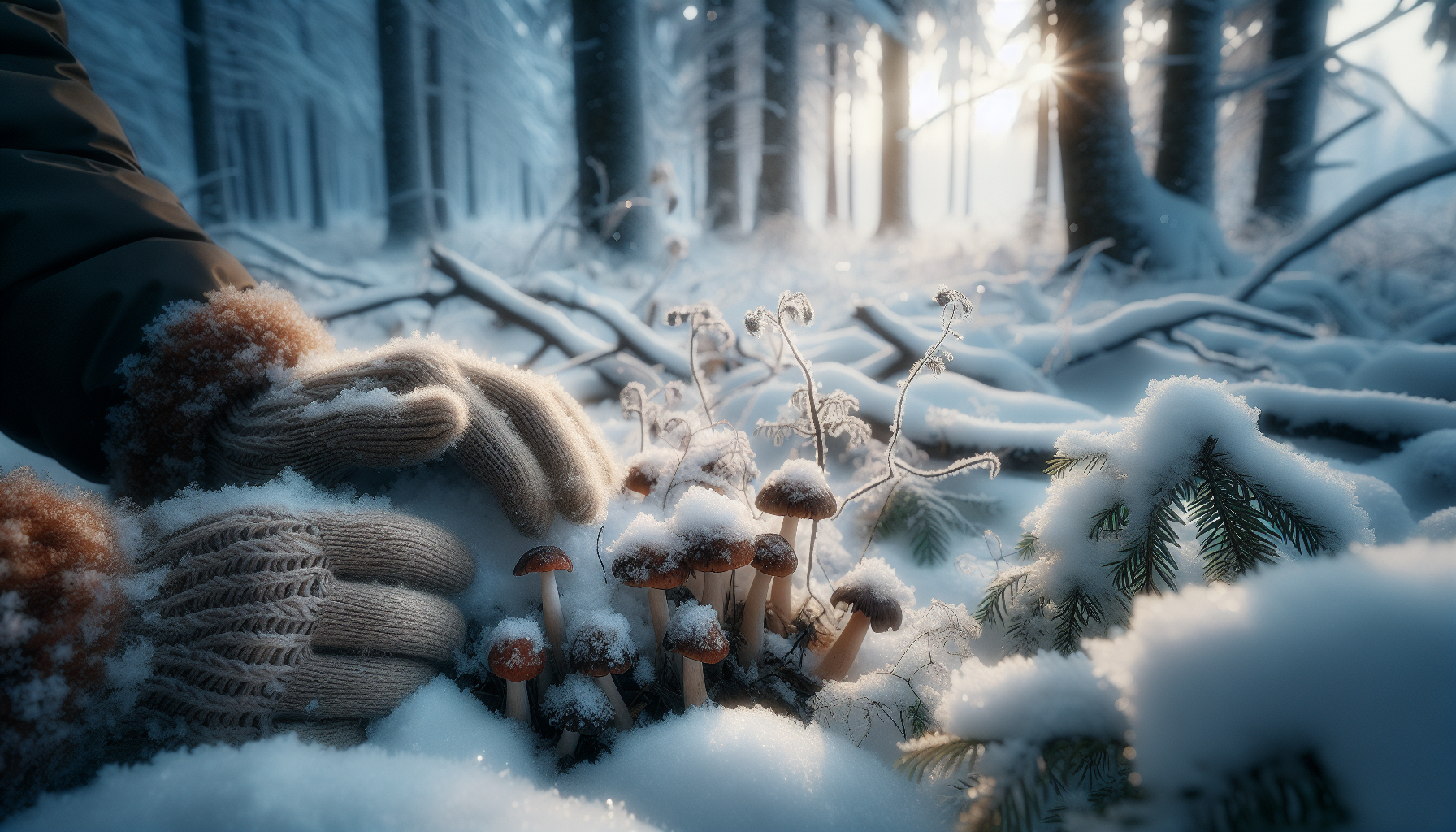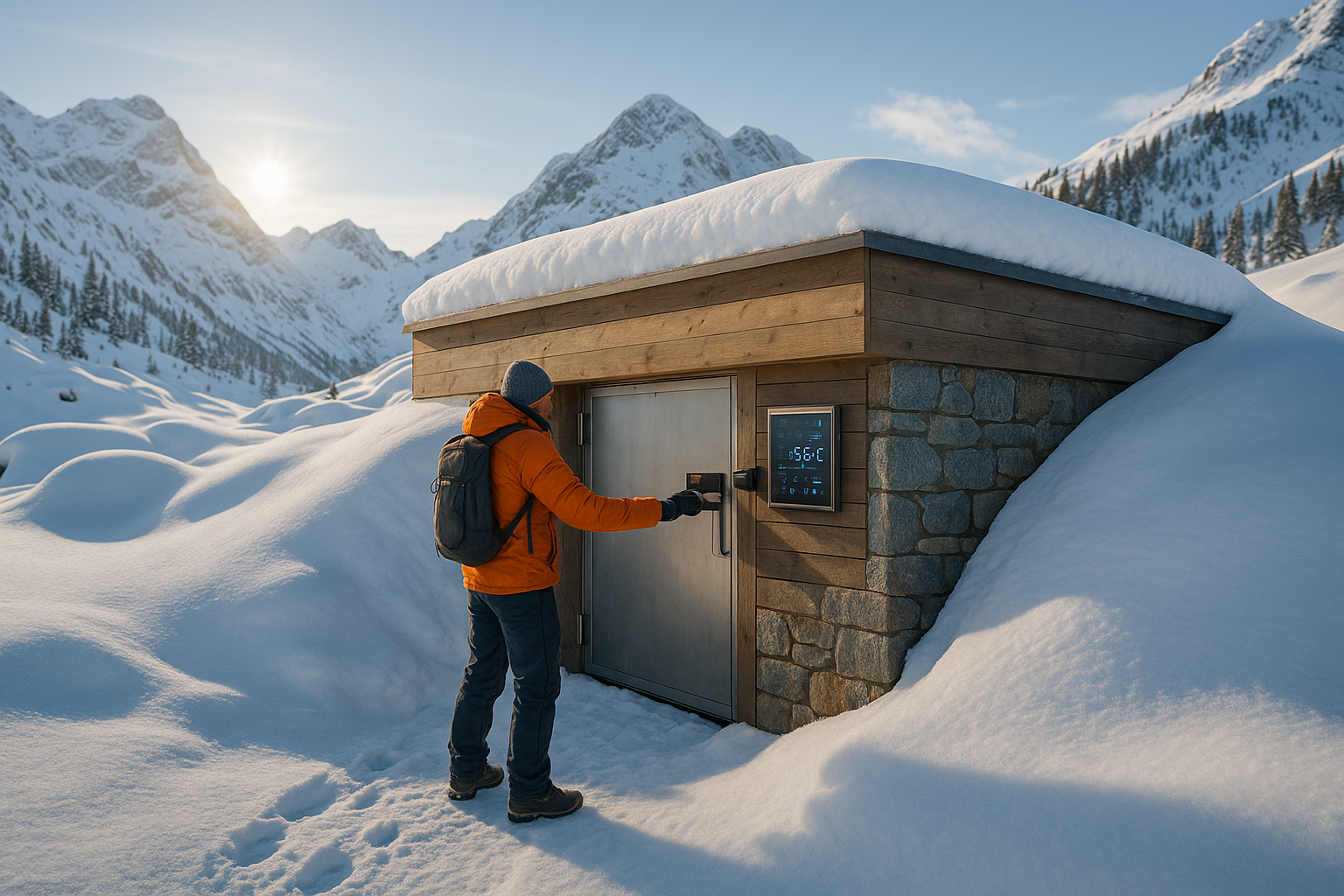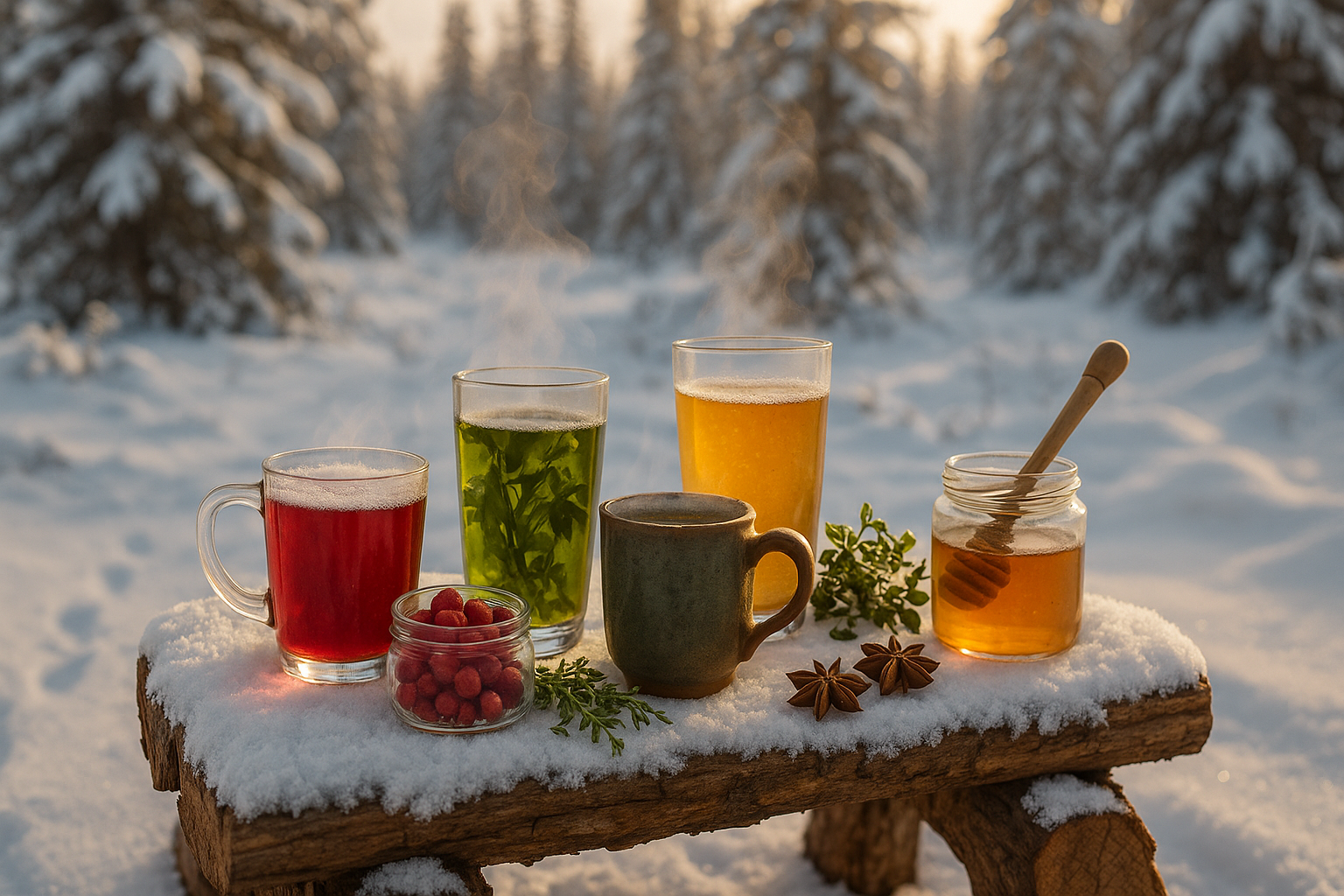As the first flakes of snow begin to fall, transforming the landscape into a winter wonderland, nature seemingly pulls a thick, white blanket over its treasures. The world outside appears dormant, the vibrancy of summer and the abundance of autumn quietly replaced by a serene, monochromatic calm. Yet, beneath this tranquil facade lies an often-overlooked secret: winter is a season of bounty for those willing to seek it. Foraging under snow layers might seem like an unlikely adventure, but it is one filled with the promise of discovery and the joy of connecting with nature in its most serene state. 🌨️
In this blog post, we will journey into the world of winter foraging, an art form that requires a keen eye, a touch of patience, and a spirit of exploration. We will delve into the skills necessary to identify and harvest hidden edible treasures buried beneath the snow. From nutrient-rich roots and tubers to hardy winter greens, we’ll explore what Mother Nature has tucked away for the discerning forager. Whether you’re a seasoned forager or a curious beginner, this guide will equip you with the knowledge and confidence to venture out into the frosty wilderness and emerge with a basketful of nature’s winter bounty.
As we traverse this snowy path, we will uncover the vital role of preparation and safety in winter foraging. Understanding the unique challenges and opportunities that the cold weather presents is crucial. We’ll discuss essential gear and clothing that will keep you warm and safe, ensuring that your winter expeditions are both enjoyable and fruitful. Moreover, we’ll share tips on identifying edible plants and roots, distinguishing them from their poisonous counterparts, a skill that is particularly important when the ground is covered in snow.
Finally, we will celebrate the culinary potential of these winter finds. With recipes and cooking tips, we’ll show you how to transform your foraged goods into hearty meals that warm the soul and nourish the body. From savory stews to herbal teas, the possibilities are as diverse as the landscapes you’ll explore. So grab your gloves and your sense of adventure, and let’s uncover the hidden gems of winter’s bounty together. ❄️
Understanding Winter Foraging: A Hidden Treasure
Winter foraging is an ancient practice that allows us to connect with nature and utilize its hidden treasures even under the harsh conditions of snow and ice. While many assume that the natural world goes into hibernation during the colder months, the truth is that nature offers a bounty if you know where to look and what to look for. The art of foraging under snow layers involves both understanding the ecosystem and having the skills to identify and gather edible plants, nuts, and other resources that are not immediately visible.
One of the first steps in winter foraging is understanding the types of vegetation and wildlife that remain active or available in the cold. Many plants have adapted to survive and even thrive in winter conditions. For instance, certain types of evergreen plants retain their leaves, allowing them to photosynthesize and provide essential nutrients. Additionally, roots and bulbs remain insulated by the snow, preserving their vitality for those who know where to dig.
Another crucial aspect of winter foraging is safety. The cold environment poses challenges such as icy terrain, frostbite, and limited daylight. Adequate preparation, including appropriate clothing and gear, is essential to ensure a safe and rewarding foraging experience. Familiarize yourself with the local wildlife, weather conditions, and terrain to avoid potential hazards. Always let someone know your foraging plans and estimated return time. Check out this video on winter foraging essentials to get started.
Common Edibles Found in Winter
When foraging in winter, several plants and natural resources stand out due to their availability and nutritional benefits. Among the most commonly foraged items are nuts, seeds, and certain types of berries that persist through the cold months. Additionally, mushrooms and lichens can provide sustenance if correctly identified.
Evergreen trees, such as pine and spruce, offer edible needles rich in vitamin C. These can be brewed into teas or used to flavor dishes. Similarly, wild onions and garlic can be found under the snow, providing both flavor and nutrients. When collecting these plants, ensure that you are correctly identifying them, as some lookalikes can be toxic.
Winter berries, such as rose hips and hawthorn, also remain available and can be a valuable source of vitamins and minerals. However, they require careful identification and processing to ensure they are safe to consume. Utilize resources such as field guides or expert-led foraging tours to enhance your identification skills. Below is a table comparing some common winter edibles:
| Plant | Edible Part | Nutritional Benefit |
|---|---|---|
| Pine | Needles | Rich in Vitamin C |
| Wild Onion | Bulbs | High in Antioxidants |
| Rose Hips | Fruits | High in Vitamin C and A |
Techniques for Effective Foraging
Mastering the art of winter foraging involves both knowledge and technique. One of the key skills is learning how to read the landscape even when it’s covered in snow. This involves understanding the topography, identifying tree types, and using clues such as animal tracks to guide your search. Snow acts as an insulator, and knowing where it accumulates or melts first can reveal hidden treasures.
Using tools like a sturdy digging stick or a small shovel can aid in uncovering roots and bulbs buried beneath the snow. When foraging for mushrooms, a sharp knife can help you carefully extract the fungi without damaging its mycelium, ensuring sustainability. Always carry a basket or bag to collect your finds, but be mindful of not overharvesting, as this can damage the ecosystem.
Another important technique is to forage sustainably. This means taking only what you need and leaving enough for wildlife and future growth. It also involves understanding the local regulations and guidelines regarding foraging, as some areas may have restrictions to protect endangered species or habitats. Join local foraging groups or workshops to learn from experienced foragers and to share knowledge and experiences.
Foraging Tools and Equipment
The right tools can make a significant difference in your foraging success. Here’s a list of essential items you should consider carrying:
- Warm, layered clothing to protect against cold and wet conditions.
- A sturdy basket or bag for collecting your finds.
- Field guides or apps for plant and mushroom identification.
- A small shovel or digging stick for uncovering buried items.
- A sharp knife for cutting plants and mushrooms.
- Waterproof boots and gloves to keep your hands and feet warm and dry.
Having these tools not only enhances your foraging experience but also ensures that you are prepared for the challenges that winter foraging presents. Don’t forget to check out informative resources like foraging blogs or videos that offer tips on selecting and using equipment effectively.
The Ecological Benefits of Winter Foraging
Winter foraging goes beyond simply gathering food; it plays a role in fostering a deeper connection with the environment and promoting ecological awareness. By participating in this activity, foragers can gain insights into the seasonal rhythms of nature and the adaptations of plants and animals to survive the cold months. This knowledge fosters a greater appreciation for biodiversity and the delicate balance of ecosystems.
Additionally, winter foraging encourages sustainable practices that can help preserve natural habitats. By understanding which species are abundant and which are at risk, foragers can make informed decisions that contribute to conservation efforts. The practice also reduces reliance on commercial agriculture, which often involves resource-intensive methods that can harm the environment.
Participating in winter foraging also contributes to local food security. By utilizing natural resources, communities can become less dependent on imported goods, which reduces carbon footprints and supports local economies. Sharing knowledge and resources within communities enhances resilience and fosters a sense of community well-being. Watch the following video on the ecological impact of foraging to learn more.
Building Community through Foraging
Foraging can be a communal activity that brings people together with a shared purpose. Whether through organized foraging groups or informal gatherings, these experiences allow individuals to share knowledge, stories, and resources. Such interactions promote cultural exchange and collective learning, as participants bring diverse perspectives and experiences to the table.
Many communities have begun to recognize the value of foraging as a tool for education and empowerment. Workshops, classes, and events focused on foraging can provide valuable skills and knowledge to both children and adults. By incorporating traditional ecological knowledge and modern scientific understanding, these educational initiatives foster a holistic approach to interacting with nature.
The communal aspect of foraging not only enhances individual experiences but also strengthens the fabric of communities. Sharing the bounty of a successful forage, exchanging recipes, and collaborating on preserving techniques are all ways in which people can connect and support each other. Embrace the opportunity to engage with your community through foraging and explore the rich tapestry of nature’s winter offerings.

Conclusion
In conclusion, the exploration of nature’s winter bounty through the art of foraging beneath layers of snow unveils a hidden world teeming with life and nourishment. This article has delved into various aspects of this fascinating topic, offering insights into the techniques, benefits, and ethics of winter foraging. By recapitulating these points, we gain a clearer understanding of the significance of engaging with nature in this unique and enriching way.
Firstly, we explored the fundamental techniques required for successful winter foraging. Identifying plants that thrive beneath the snow, such as certain root vegetables, hardy herbs, and nutrient-rich fungi, is a skill that can be honed through practice and experience. The importance of being equipped with the right tools, including a durable digging implement and appropriate clothing, cannot be overstated. These tools, along with a solid understanding of the landscape and its seasonal transformations, empower foragers to unearth winter’s hidden treasures with confidence and respect.
Furthermore, the article highlighted the numerous benefits associated with winter foraging. Not only does it provide a sustainable and eco-friendly source of nutrition, but it also fosters a deeper connection with the natural world. Engaging in this practice encourages mindfulness and appreciation for the delicate balance of ecosystems. It invites foragers to slow down, observe, and learn from the environment, promoting a sense of tranquility and fulfillment. Additionally, the health benefits of consuming wild, nutrient-dense foods are profound, offering a natural boost to the immune system and overall well-being.
Equally important is the discussion on the ethical considerations surrounding winter foraging. Responsible foraging practices ensure that the ecosystem remains undisturbed and capable of sustaining future growth. This involves adhering to local regulations, respecting private property, and foraging in a manner that does not deplete the natural resources. By practicing sustainable foraging, individuals contribute to the conservation of biodiversity and the preservation of habitats, ensuring that these natural treasures endure for generations to come.
As we reinforce the importance of winter foraging, it becomes evident that this activity is not merely about gathering food but is a holistic experience that enriches the soul and nurtures a profound bond with nature. In a world increasingly dominated by urbanization and technological advancements, the simplicity and authenticity of foraging offer a refreshing counterbalance. It is a reminder of our roots, our dependency on the earth, and the resilience of nature itself.
To encourage the reader to take action, consider this: By sharing your foraging experiences, insights, and discoveries with others, you contribute to a growing community of nature enthusiasts who are passionate about sustainable living. Social media platforms and local workshops provide excellent opportunities to connect with like-minded individuals, exchange knowledge, and inspire others to embark on their own foraging adventures. By spreading awareness and fostering a sense of community, we can collectively cultivate a more sustainable and harmonious relationship with the natural world.
Moreover, applying the knowledge gained from winter foraging to everyday life can lead to transformative changes. Incorporating wild foods into your diet not only diversifies your culinary experiences but also encourages a shift towards more conscious consumption patterns. Understanding the seasonal availability of different plants can influence our food choices, reducing reliance on mass-produced, out-of-season produce. This shift supports local ecosystems and reduces our carbon footprint, contributing to a healthier planet.
In conclusion, the art of foraging under snow layers is a testament to the resilience of both nature and the human spirit. It invites us to embrace the beauty of the colder months, uncovering the hidden abundance that lies beneath the surface. By adopting sustainable foraging practices, sharing our experiences, and integrating these lessons into our lives, we become stewards of the environment, fostering a legacy of respect and harmony with the earth.
As you reflect on the insights shared in this article, consider embarking on your own winter foraging journey. Embrace the challenges and rewards that come with it, and let the wonders of nature inspire you. 🌿❄️
For more information on responsible foraging and to connect with a community of enthusiasts, visit reputable sources like the Wild Food UK or explore local foraging groups and workshops in your area.
Remember, the earth provides abundantly for those who seek its treasures with gratitude and respect. Let us embark on this journey together, nurturing a sustainable future for ourselves and the generations to come.





